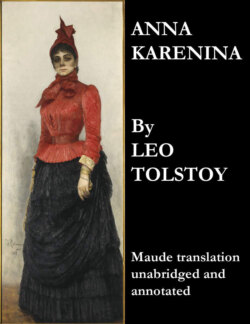Читать книгу Anna Karenina (Maude Translation, Unabridged and Annotated) - Leo Tolstoy - Страница 4
На сайте Литреса книга снята с продажи.
Preface to the Maude Translation
ОглавлениеTOC
ANNA KARENINA, the second of Tolstoy’s great novels, was begun in 1873 when he was forty-five, and its publication was completed in 1877, when he was passing through the spiritual crisis described in his Confession, a book for which the last chapters of Anna Karenina may serve as an introduction, and which was the next work he wrote.
Besides being a splendid novel, Anna Karenina is of great autobiographical value. It was Tolstoy’s way to put much of himself into his characters, but in none of them has he so frankly depicted himself as in Levin, the hero of this story. The description of Levin’s estate is largely drawn from Tolstoy’s own patrimony, Yasnaya Polyana. The character of the old servant, Agatha Mikhaylovna, is drawn from a retainer of his. Nicholas Levin is Tolstoy’s brother, Dmitry. The way in which Levin proposes to Kitty, by writing only the initial letters of the words he wants to say, was an incident in Tolstoy’s own courtship of his wife. Levin’s contempt for the Zemstvo (of which, like Tolstoy, he was a member for only a short time) expresses the author’s own feeling, as does Levin’s censure of the Russian Volunteers who joined in the struggle between Turkey and its Christian subjects in the days preceding the Russo-Turkish war of 1877.
On that matter Tolstoy opposed what appeared to be the prevalent feeling of the Russian nation, and he did the same on the yet more fundamental problem of marriage. Russian divorce law was extremely rigid, but the general trend of the Russian Liberal movement, both in life and in literature, for a generation before Anna Karenina appeared had been opposed to regarding the marriage ceremony as a sentence for life. This book was therefore considered reactionary, and its author was, for a while, classed among the Conservatives. It is, however, absurd to blame a novelist for depicting a happy marriage and a disastrous illicit passion, for certainly such things are met with in real life, and no one need generalize from a particular example.
The book contains one incident the credibility of which has sometimes been questioned. It is said that Vronsky could not have broken his horse’s back in the way depicted in the steeplechase, but I am informed by a very competent authority that just such accidents have actually occurred. A rider by sitting back when jumping a ditch may jerk up his horse’s head and so cause it to drop its hind legs into the ditch, thus breaking its back. It is, moreover, just at narrow ditches, as in Tolstoy’s description, that this is most likely to occur.
Readers of Tolstoy’s books often wish to know something of the author’s life. I may therefore perhaps be allowed to mention that Messrs. Methuen are just publishing a short life of Leo Tolstoy, condensed from the two-volume Life of him which I wrote just before he died.
As English readers are sometimes in doubt where to place the accent on Russian names, a list of characters with the names accentuated is supplied, as also is a list of the Russian words, weights and measures mentioned in the book.
The translators desire to express their thanks to the friends who have assisted them with advice and information during the preparation of this work, and in particular to thank Mr. Benjamin Grad for his kind cooperation.
AYLMER MAUDE
26 January 1918
